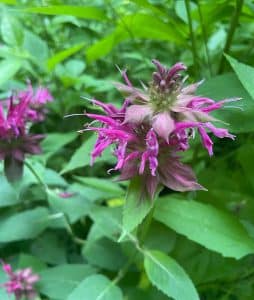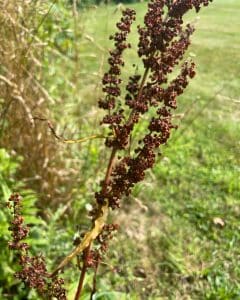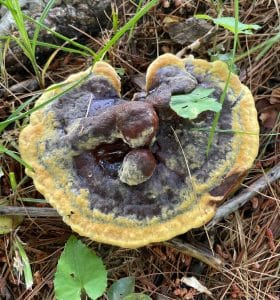Among the most highly prized mushrooms are the chanterelles. These trumpet-shaped mushrooms are flavorful and firm, and generally have false gills that are thicker and shallower than the true gills found on many other mushrooms that look like pages in a book. The chanterelle’s false gills are often also forked at one end. Their name comes from the Greek kantharos, which means cup; this refers to the cup-shaped depression at the center of the cap, as well as the overall shape.
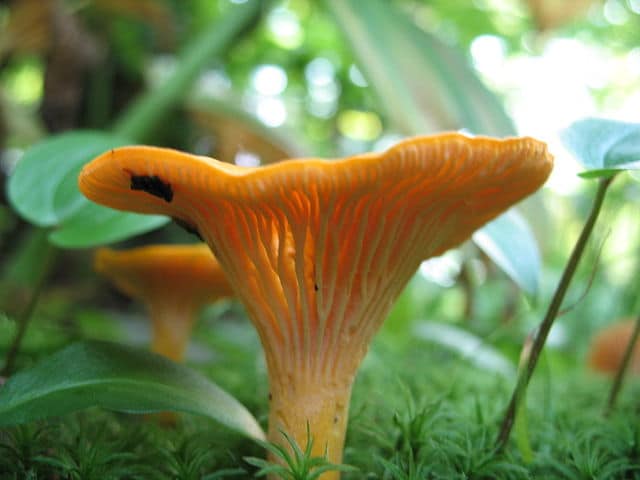
Species
“Chanterelle” refers to a variety of similar mushrooms in the genera Cantharellus, Polyozellus, Gomphus, and Craterellus. A few common western North American species include:
Pacific golden chanterelle (Cantharellus formosus): one of the golden-yellow chanterelles, it has a mycorrhizal relationship with western hemlock (Tsuga heterophylla) and Douglas fir (Pseudotsuga menziesii) trees and can often be found growing beneath them.
White chanterelle (Cantharellus subalbidus): this white mushroom may bruise or stain yellow or orange when damaged, but is quite edible. It is mycorrhizal with several species of conifer, as well as madrone.
Yellowfoot (Craterellus tubaeformis, formerly Cantharellus tubaeformis): This mushroom has a yellow stipe but a brownish cap. It is mycrorrhizal with Douglas fir and western hemlock.
Black trumpet (Craterellus cornucopioides): Black on top, with a gray underside, this chanterelle lacks gills or false gills on the underside.
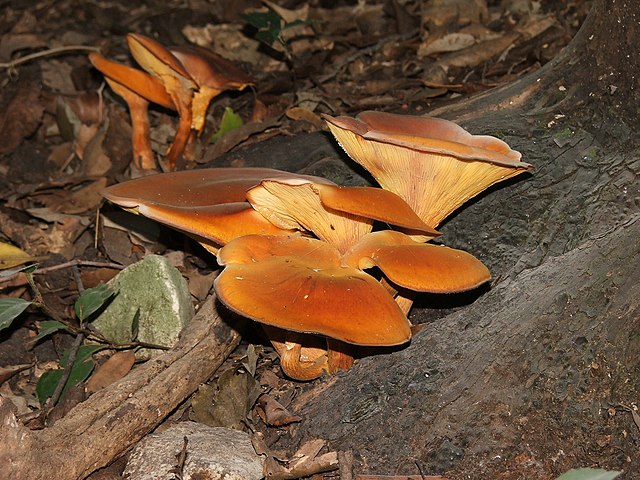
Lookalikes
The false chanterelle (Hygrophoropsis aurantiaca) looks similar to golden chanterelles, but it is often a darker orange, and it has true gills. Sources vary as to whether it is mildly poisonous, inedible, or edible but not especially tasty.
Jack o’Lantern (Omphalotus spp.), pictured above, are also orange and are often mistaken for golden chanterelles. However, they have true gills, and they grow on wood rather than soil. They are quite poisonous, and while they likely won’t kill you, they will give you some truly awful gastrointestinal distress.
Where to Find Chanterelles
Most chanterelles grow in soil, not wood, though yellowfoot will grow in either. Chanterelles may begin to fruit in summer at lower elevations, and later at higher elevations. In the Pacific Northwest, fall is prime chanterelle hunting time, especially in the Coast Range of Oregon and the Cascades. Yellowfoot may be found into winter in milder climates.
Look for trees that have mycorrhizal relationships with chanterelles; these will usually be conifers. They tend to prefer shaded areas, rather than open meadows which are too dry. You may have to look under leaf litter and shrubs to find them.

Can Chanterelles Be Cultivated?
The short version is: generally no, at least not under conditions that more easily cultivated mushrooms may be grown. You can’t just drop some spawn onto a hay bale. Because many chanterelle species are mycorrhizal with live trees, they need to exchange vital nutrients with their tree partners. Some people have reported success by sowing the soil at the roots of potential partner trees with spawn or pieces of chanterelle mushroom caps. However, this is a hit or miss effort, and if someone had been able to come up with a truly easily replicable method of chanterelle cultivation they would have made a fortune on it by now.
Cooking Chanterelles
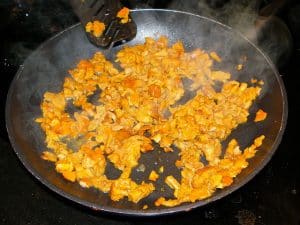
To me, there are few things more sublime than fresh chanterelles sliced and sauteed in butter. However, these flavor-packed mushrooms are excellent in omelettes and other eggs, in rice (including risotto!), pasta, soup, and much more. They are a little more delicate than some mushrooms, but hold their texture as long as they aren’t overcooked. To preserve them, dry-sautee them over medium to medium-high heat with a little salt until the extra juice cooks off, then freeze them.
Conclusion
Finding chanterelles can be a challenge, especially in areas with a lot of other foragers. But if you manage to find a nice flush of them, make sure you remember that spot for next year! These choice mushrooms are well worth the effort to track down.
—————
Written by Rebecca Lexa
Rebecca Lexa is a certified Master Naturalist in the Pacific Northwest. She teaches classes on foraging and other natural history topics, both online and off. More about her work can be found at http://www.rebeccalexa.com.
Many of our readers find that subscribing to Eat The Planet is the best way to make sure they don't miss any of our valuable information about wild edibles.
See our privacy policy for more information about ads on this site

